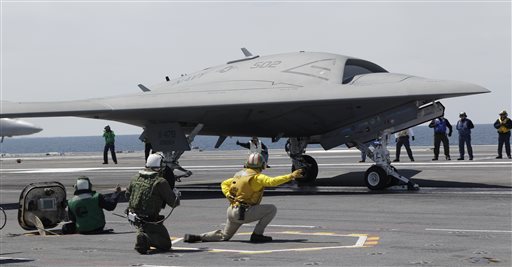(AP) Navy to attempt 1st unmanned carrier landing
By BROCK VERGAKIS
Associated Press
NORFOLK, Va.
The Navy will attempt to land a drone the size of a fighter jet aboard an aircraft carrier for the first time Wednesday, showcasing the military’s capability to have a computer program perform one of the most difficult tasks a pilot is asked to do.
If all goes as planned, a successful landing of the X-47B experimental aircraft will mean the Navy can move forward with its plans to develop another unmanned aircraft that will join the fleet alongside traditional airplanes to provide around-the-clock surveillance while also possessing a strike capability. The aircraft’s success would pave the way for the U.S. to launch unmanned aircraft without the need to obtain permission from other countries to use their bases.
The X-47B experimental aircraft will take off from Naval Air Station Patuxent River in Maryland before approaching the USS George H.W. Bush, which is operating off the coast of Virginia. The drone will try to land by deploying a tailhook that will catch a wire aboard the ship and bring it to a quick stop, just like normal fighter jets do. The maneuver is known as an arrested landing and has previously only been done by the drone on land at Patuxent River. Landing on a ship that is constantly moving while navigating through turbulent air behind the aircraft carrier is seen as a more difficult maneuver.
Just like a traditional airplane, if the landing has to be called off for any reason at the last second, it can perform a touch-and-go maneuver. It performed nine such maneuvers in May, when it also took off from an aircraft carrier for the first time.
The X-47B will never be put into operational use, but it will help Navy officials develop future carrier-based drones. Those drones could begin operating by 2020, according to Winter. Four companies are expected to compete for a contract to design the future unmanned aircraft, which will be awarded in Fiscal Year 2014.
The two experimental aircrafts that have been built for the first round of testing will be retired and placed in museums at Patuxent River and at Naval Air Station Pensacola in Florida.
The move to expand the capabilities of the nation’s drones comes amid growing criticism of America’s use of Predators and Reapers to gather intelligence and carry out lethal missile attacks against terrorists in Iraq, Afghanistan, Pakistan and Yemen.
Critics in the U.S. and abroad have charged that drone strikes cause widespread civilian deaths and are conducted with inadequate oversight. Still, defense analysts say drones are the future of warfare.
The X-47B is far bigger than the Predator, has three times the range and can be programmed to carry out missions with no human intervention, the Navy said.
While the X-47B isn’t a stealth aircraft, it was designed with the low profile of one. That will help in the development of future stealth drones, which would be valuable as the military changes its focus from the Middle East to the Pacific, where a number of countries’ air defenses are a lot stronger than Afghanistan’s.
The X-47B has a wingspan of about 62 feet and weighs 14,000 pounds, versus nearly 49 feet and about 1,100 pounds for the Predator.
While Predators are typically piloted via remote control by someone in the U.S., the X-47B relies only on computer programs to tell it where to fly unless a human operator needs to step in. The Navy says the aircraft relies on precision GPS navigation, a high-integrity network connection and advanced flight control software to guide itself.
Developed by Northrop Grumman under a 2007 contract at a cost of $1.4 billion, the X-47B is capable of carrying weapons and is designed to be the forerunner for a drone program that will provide around-the-clock intelligence, surveillance and targeting, according to the Navy, which has been giving updates on the project over the past few years.
The X-47B can reach an altitude of more than 40,000 feet and has a range of more than 2,100 nautical miles, versus 675 for the Predator. The Navy plans to show the drone can be refueled in flight, which would give it even greater range.
___
Brock Vergakis can be reached at www.twitter.com/BrockVergakis.

COMMENTS
Please let us know if you're having issues with commenting.